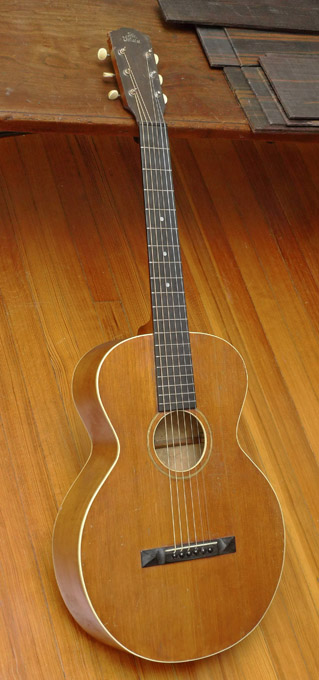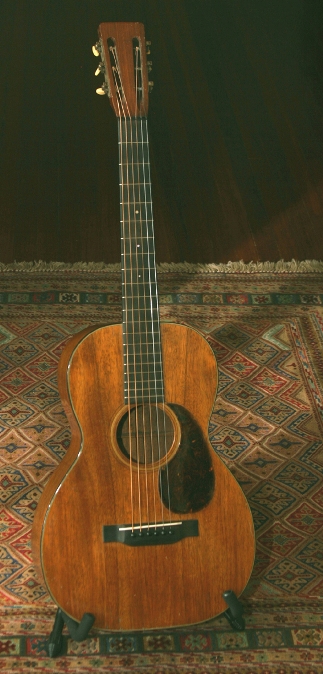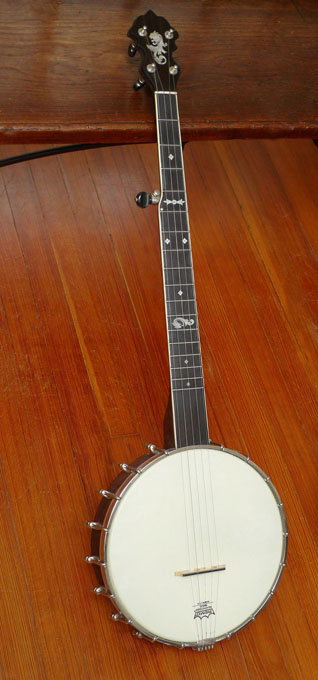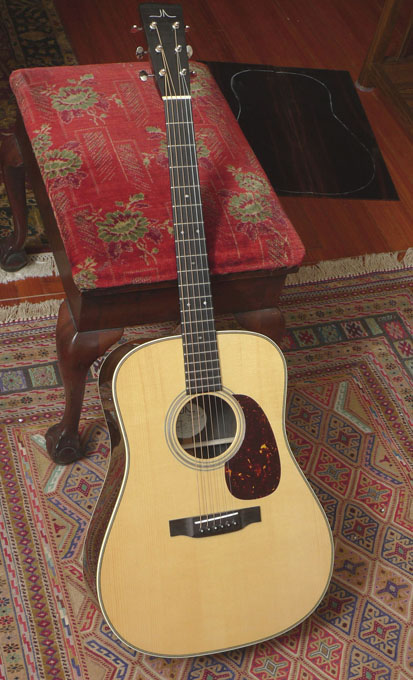This historically significant Gibson L-1, 12-fret flat top guitar, is the earliest true Gibson flat top guitar on the market today. As well as the one in the best, original condition. And it is a rare example, exhibiting transitional features that place it just barely after the 1926 introduction– yet still a 1926 model (Factory order number: 8406)– but leaning toward a few subsequent, very early changes that would establish Gibson on the flat top scene that Martin had carved out so well.
Introduced in '26 (there was already a L-1 archtop), the original Gibson L-1 flat top had a 13-1/2" body, wide V-neck, and H-bracing. The L-1 later achieved fame due to its association with the legendary bluesman Robert Johnson. Its rounded lower bout, combined with narrow waist, is distinctive. And its thin braces, thin finish, and thin woods give it a wonderful woody yet loud, cutting, bluesy tone that no 1930’s– much less more modern– Gibson or Martin could achieve.
It is the transitional nature of this particular guitar, that is intriguing. The very first L-1 flat top, had an arched back (birch, or maple), and a pretty fat V-shaped neck. Other traits of the very first L-1 flat top: single bound top; maple back and sides; no truss rod; unbound ebony fingerboard; H pattern top bracing; “The Gibson” paint logo straight across peghead; light amber top finish; Sheraton brown finish on back and sides; single bound back.
But this L-1, though very early, does not have arched back, but rather a true flat top-style back. And its neck is a great-playing C shape, not overly fat, and not a V shape. Furthermore, it has “A” bracing, not the standard H bracing. Finally, this guitar has a (original) ebony fretboard with virtually no radius. It’s a true “transition” example. It is notably not a hybrid put together from old L-1 archtop parts– as were the very first L-1 “flat tops” out of the gate in 1926.
These are the traits of this early Gibson L-1 flat top:
- Single bound, red spruce top, with amber stain
- Original ebony bridge; original cellulose bridge pins (unslotted)
- Maple back and sides (back is not arched), with Sheraton brown finish
- Mahogany neck, C-shaped
- Original, very thin maple bridge plate, tucked under braces, and extending all the way to the kerfing at the sides of the top, and tucked under the Kerfing
- No truss rod
- Unbound ebony fingerboard (not “ebonized”, but solid ebony)
- “The Gibson” paint logo straight across peghead
- Single bound (ivoroid) top
- Single bound (ivoroid) back
- H bracing (a slight variation of “A” bracing; with the apex at either side of the neck block– and the braces actually tuck beneath the neck block)
- Pearl dots on 5,7, and 9 frets
- Original three-on-a-plate tuners, with plastic tuner buttons
- Original frets
- Original ebony nut
- 13 5/8 inch, lower bout
- 24 1/2 inch scale (not the 25 inch scale that was soon settled on by Gibson for the L-1, soon after the introduction)
- Nut width: just shy of 1 7/8 inch
- Width of fretboard at 12th fret: 2 ¼ inch
- String spacing at nut: a hair over 1 ½ inch
- String spacing at bridge: 2 3/8 inch
- Three well-repaired top cracks (all, with the grain; and the amber finish on top is very forgiving, in terms of appearance, so cracks are hardly visible)
- One replaced tuner post
Every part of this guitar is original, except a new saddle, and the one replaced tuner post. Even the bridge pins are original. The neck was just set by us, perfectly. Intonation is perfect, all the way up to the high frets. Action: 3/32 over 4/32 inch (high E; low E, at 12 fret).
This guitar is a rare example of the first true Gibson flat top, and is the earliest made on the market that is indeed a true Gibson flat top– not a hybrid Gibson archtop/flat top. If you acquire this guitar, you’ll have boasting rights to the first Gibson flat top still in existence. But that’s all for show. More than anything, this guitar plays beautifully. It’s hard to put down. Its tone is wonderful. It has clear, glassy trebles that only the combination of maple back and sides with the very thin build, can deliver. This is a guitar whose trebles and mids you will not find on any other instrument. It is a combination of that uncompromised, pure woody tone from the great 20’s flat tops, but with the clear, louder trebles and mids that are haunting, and fill the room, even with the lightest touch.
 This historically significant Gibson L-1, 12-fret flat top guitar, is the earliest true Gibson flat top guitar on the market today. As well as the one in the best, original condition. And it is a rare example, exhibiting transitional features that place it just barely after the 1926 introduction– yet still a 1926 model (Factory order number: 8406)– but leaning toward a few subsequent, very early changes that would establish Gibson on the flat top scene that Martin had carved out so well. Introduced in '26 (there was already a L-1 archtop), the original Gibson L-1 flat top had a 13-1/2" body, wide V-neck, and H-bracing. The L-1 later achieved fame due to its association with the legendary bluesman Robert Johnson. Its rounded lower bout, combined with narrow waist, is distinctive. And its thin braces, thin finish, and thin woods give it a wonderful woody yet loud, cutting, bluesy tone that no 1930’s– much less more modern– Gibson or Martin could achieve. It is the transitional nature of this particular guitar, that is intriguing. The very first L-1 flat top, had an arched back (birch, or maple), and a pretty fat V-shaped neck. Other traits of the very first L-1 flat top: single bound top; maple back and sides; no truss rod; unbound ebony fingerboard; H pattern top bracing; “The Gibson” paint logo straight across peghead; light amber top finish; Sheraton brown finish on back and sides; single bound back. But this L-1, though very early, does not have arched back, but rather a true flat top-style back. And its neck is a great-playing C shape, not overly fat, and not a V shape. Furthermore, it has “A” bracing, not the standard H bracing. Finally, this guitar has a (original) ebony fretboard with virtually no radius. It’s a true “transition” example. It is notably not a hybrid put together from old L-1 archtop parts– as were the very first L-1 “flat tops” out of the gate in 1926. These are the traits of this early Gibson L-1 flat top:
This historically significant Gibson L-1, 12-fret flat top guitar, is the earliest true Gibson flat top guitar on the market today. As well as the one in the best, original condition. And it is a rare example, exhibiting transitional features that place it just barely after the 1926 introduction– yet still a 1926 model (Factory order number: 8406)– but leaning toward a few subsequent, very early changes that would establish Gibson on the flat top scene that Martin had carved out so well. Introduced in '26 (there was already a L-1 archtop), the original Gibson L-1 flat top had a 13-1/2" body, wide V-neck, and H-bracing. The L-1 later achieved fame due to its association with the legendary bluesman Robert Johnson. Its rounded lower bout, combined with narrow waist, is distinctive. And its thin braces, thin finish, and thin woods give it a wonderful woody yet loud, cutting, bluesy tone that no 1930’s– much less more modern– Gibson or Martin could achieve. It is the transitional nature of this particular guitar, that is intriguing. The very first L-1 flat top, had an arched back (birch, or maple), and a pretty fat V-shaped neck. Other traits of the very first L-1 flat top: single bound top; maple back and sides; no truss rod; unbound ebony fingerboard; H pattern top bracing; “The Gibson” paint logo straight across peghead; light amber top finish; Sheraton brown finish on back and sides; single bound back. But this L-1, though very early, does not have arched back, but rather a true flat top-style back. And its neck is a great-playing C shape, not overly fat, and not a V shape. Furthermore, it has “A” bracing, not the standard H bracing. Finally, this guitar has a (original) ebony fretboard with virtually no radius. It’s a true “transition” example. It is notably not a hybrid put together from old L-1 archtop parts– as were the very first L-1 “flat tops” out of the gate in 1926. These are the traits of this early Gibson L-1 flat top: We converted this Golden Era 12-fret Koa Martin from the original Hawaiian setup ourselves, so it's perfect. The instrument does not have a crack anywhere. All original finish. Original Ebony bridge, converted from the tall Hawaiian set-up to a normal 30's set-up. Same with the ebony nut. All new, period-perfect Bar Frets. We radiused the ebony fretboard to 30's Martin specs. Neck was set and action is perfect. 1-7/8 inch nut width. Original tuners. Original bridge plate. Minor nicks and dings on top and back, but with the all original finish and crack-free, it's a rare specimen. Nothing compares in tone to an all-Koa Golden Age Martin. Koa blends the midrange of mahogany with the top end of maple-or, in the case of a fine 30's Koa Martin- hints of Brazilian rosewood. This fine 0-18K has all you would want from a Koa Martin, with the clearest, bell-like treble string tone imaginable.
We converted this Golden Era 12-fret Koa Martin from the original Hawaiian setup ourselves, so it's perfect. The instrument does not have a crack anywhere. All original finish. Original Ebony bridge, converted from the tall Hawaiian set-up to a normal 30's set-up. Same with the ebony nut. All new, period-perfect Bar Frets. We radiused the ebony fretboard to 30's Martin specs. Neck was set and action is perfect. 1-7/8 inch nut width. Original tuners. Original bridge plate. Minor nicks and dings on top and back, but with the all original finish and crack-free, it's a rare specimen. Nothing compares in tone to an all-Koa Golden Age Martin. Koa blends the midrange of mahogany with the top end of maple-or, in the case of a fine 30's Koa Martin- hints of Brazilian rosewood. This fine 0-18K has all you would want from a Koa Martin, with the clearest, bell-like treble string tone imaginable. This is a one-of-a-kind custom banjo, from one of the country’s most respected luthiers, based in Appomattox, Virginia. I love this banjo for picking on the couch– it won’t put your back out, picking it up and putting it down, or crush your cat or your sweetheart. It’s lightweight, and with a custom-size head. But it packs beautiful full tone, not the tinny nasal sound from most open back banjos. It’s five or so years old, but with very little wear.
This is a one-of-a-kind custom banjo, from one of the country’s most respected luthiers, based in Appomattox, Virginia. I love this banjo for picking on the couch– it won’t put your back out, picking it up and putting it down, or crush your cat or your sweetheart. It’s lightweight, and with a custom-size head. But it packs beautiful full tone, not the tinny nasal sound from most open back banjos. It’s five or so years old, but with very little wear. This is a new Allison Brazilian Rosewood dreadnought. Austin-based John Allison was a key part of the Collings Guitar team for years. John is now one of the most sought-after independent makers of fine instruments in the southwest. His guitars are carried by a number of top dealers in the U.S… and we’ve just snagged this brand new, wonderful Brazilian– a custom order guitar. Allison’s attention to detail is astounding. You just have to see and play this great brazilian. Right off the bench, it’s loud and beguiling, and it will only get better over time.
This is a new Allison Brazilian Rosewood dreadnought. Austin-based John Allison was a key part of the Collings Guitar team for years. John is now one of the most sought-after independent makers of fine instruments in the southwest. His guitars are carried by a number of top dealers in the U.S… and we’ve just snagged this brand new, wonderful Brazilian– a custom order guitar. Allison’s attention to detail is astounding. You just have to see and play this great brazilian. Right off the bench, it’s loud and beguiling, and it will only get better over time. The Larson Brothers of Chicago never marketed any guitar, throughout their long career, that was marked “Larson”. Their designs were branded by Maurer, Stahl, Prarie State, Stetson, and a few other guitar makers– but never “Larson”. They were also known for making many “off-catalog” guitars, i.e. guitars with combinations of features that varied from the Maurer, Stahl, etc, catalogs, and guitars that were not marked at all with a brand. This guitar is a Larson Bros creation that is not marked at all. It is a custom made instrument–but it has all the typical Larson hallmarks. The tone of this Larson is every bit as wonderful as the Maurer/Larson listed above, indeed it is quite similar, due to the same patented “built under tension” design, and X-bracing. This Larson does not have laminated braces (it’s well documented that laminated braces were only used on certain models–and their use was not related to level or price.) Every part of this guitar is original, including original finish. There are two repaired cracks on the back, and three small, repaired cracks on top.
The Larson Brothers of Chicago never marketed any guitar, throughout their long career, that was marked “Larson”. Their designs were branded by Maurer, Stahl, Prarie State, Stetson, and a few other guitar makers– but never “Larson”. They were also known for making many “off-catalog” guitars, i.e. guitars with combinations of features that varied from the Maurer, Stahl, etc, catalogs, and guitars that were not marked at all with a brand. This guitar is a Larson Bros creation that is not marked at all. It is a custom made instrument–but it has all the typical Larson hallmarks. The tone of this Larson is every bit as wonderful as the Maurer/Larson listed above, indeed it is quite similar, due to the same patented “built under tension” design, and X-bracing. This Larson does not have laminated braces (it’s well documented that laminated braces were only used on certain models–and their use was not related to level or price.) Every part of this guitar is original, including original finish. There are two repaired cracks on the back, and three small, repaired cracks on top.